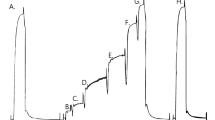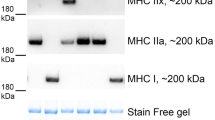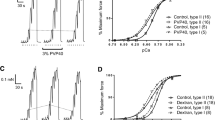Summary
The effects of saponin onXenopus and frog skeletal muscle fibres were examined. The twitch ofXenopus single fibres was first potentiated slightly and then irreversibly abolished by 5–10 µg/ml of saponin. Treatment with saponin at 5–10 µg/ml or higher concentrations for 30 min resulted in perforation of the muscle cell membrane, indicated by the following evidence. (i) Fibres became responsive to contractile activating solutions with a pCa-tension relationship similar to that of mechanically skinned fibres. (ii) Removal and re-introduction of MgATP became effective in bringing fibres into rigor and the relaxed state, respectively. (iii) After the saponin treatment large contractions due to Ca release from the SR could be elicited by substitution of Cl for methanesulphonate in the medium. (iv) The treatment decreased the optical path length across the fibre, indicating loss of soluble proteins. (v) The lattice spacing of myofilaments was wider after the treatment as in mechanically skinned fibres. Contractile response of mechanically skinned fibres and their SR responses such as Ca uptake, Ca-induced Ca release and Cl-induced Ca release were not affected by treatment with 50 µg/ml saponin for 30 min, while 150 µg/ml or higher concentrations severely impaired the SR functions. It is possible, therefore, to make chemically skinned skeletal muscle fibres in which the functions of the SR are preserved by applying 10–50 µg/ml saponin.
Similar content being viewed by others
References
ALLEN, D. G., BLINKS, J. R. & PRENDERGAST, F. G. (1977) Aequorin luminescence: relation of light emission to calcium concentration — a calcium-independent component.Science 195, 996–8.
ASHLEY, C. C. & MOISESCU, D. G. (1977) Effect of changing the composition of the bathing solutions upon the isometric tension-pCa relationship in bundles of crustacean myofibrils.J. Physiol. 270, 627–52.
BLAUSTEIN, M. P., RATZLAFF, R. W., KENDRICK, N. C. & SCHWEITZER, E. S. (1978) Calcium buffering in presynaptic nerve terminals. I. Evidence for involvement of a non-mitochondrial ATP-dependent sequestration mechanism.J. gen. Physiol. 72, 15–41.
ENDO, M. (1967) Regulation of contraction-relaxation cycle of muscle (in Japanese).Proc. 17th Gen. Assemb. Jap. Med. Congr. 1, 193–7.
ENDO, M. (1975) Mechanism of action of caffeine on the sarcoplasmic reticulum of skeletal muscle.Proc. Jap. Acad. 51, 479–84.
ENDO, M. (1976) Effects of some detergents on surface membrane and sarcoplasmic reticulum of skeletal muscle (in Japanese).Folia pharmacol. jap. 72, 9–10P.
ENDO, M. & KITAZAWA T. (1978) E-C coupling studies on skinned cardiac fibers. InBiophysical Aspects of Cardiac Muscle (edited by MORAD, M.), pp. 307–327. New York: Academic Press.
ENDO, M., KITAZAWA, T., YAGI, S., IINO, M. & KAKUTA, Y. (1977) Some properties of chemically skinned smooth muscle fibers. InExcitation-Contraction Coupling in Smooth Muscle (edited by CASTEELS, R., GODFRAIND, T. & RÜEGG, J. C.), pp. 199–209. Amsterdam: Elsevier.
ENDO, M. & NAKAJIMA, Y. (1973) Release of calcium induced by ‘depolarisation’ of the sarcoplasmic reticulum membrane.Nature (New Biol.) 246, 216–8.
HUXLEY, H. E. & BROWN, W. (1967) The low-angle X-ray diagram of vertebrate striated muscle and its behaviour during contraction and rigor.J. molec. Biol. 30, 383–434.
JULIAN, F. J. (1971) The effect of calcium on the force-velocity relation of briefly glycerinated frog muscle fibres.J. Physiol. 218, 117–45.
MARTONOSI, A. (1968) Sarcoplasmic reticulum. V. The structure of sarcoplasmic reticulum membranes.Biochim. biophys. Acta 150, 694–704.
MATSUBARA, I. & ELLIOTT, G. F. (1972) X-ray diffraction studies on skinned single fibres of frog skeletal muscle.J. molec. Biol. 72, 657–69.
NATORI, R. (1954) The property and contraction process of isolated myofibrils.Jikeikai Med. J. 1, 119–26.
OGAWA, Y. (1968) The apparent binding constant of glycoletherdiaminetetraacetic acid for calcium at neutral pH.J. Biochem. 64, 255–7.
OHTSUKI, I., MANZI, R. M., PALADE, G. E. & JAMIESON, J. D. (1978) Entry of macromolecular tracers into cells fixed with low concentrations of aldehydes.Biol. cellulaire 31, 119–26.
OHTSUKI, I. & OZAWA, E. (1977) Difference in saponin sensitivity between myotubes and mononucleated cells from chick breast muscle.Cell Structure and Function 2, 367–70.
SZENT-GYÖRGYI, A. (1949) Free-energy relations and contraction of actomyosin.Biol. Bull. 96, 140–61.
WAKU, K., UDA, Y. & NAKAZAWA, Y. (1971) Lipid composition in rabbit sarcoplasmic reticulum and occurrence of alkyl ether phospholipids.J. Biochem. 69, 483–91.
Author information
Authors and Affiliations
Rights and permissions
About this article
Cite this article
Endo, M., Iino, M. Specific perforation of muscle cell membranes with preserved SR functions by saponin treatment. J Muscle Res Cell Motil 1, 89–100 (1980). https://doi.org/10.1007/BF00711927
Received:
Issue Date:
DOI: https://doi.org/10.1007/BF00711927




